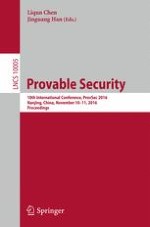2016 | Book
Provable Security
10th International Conference, ProvSec 2016, Nanjing, China, November 10-11, 2016, Proceedings
Editors: Liqun Chen, Jinguang Han
Publisher: Springer International Publishing
Book Series : Lecture Notes in Computer Science
